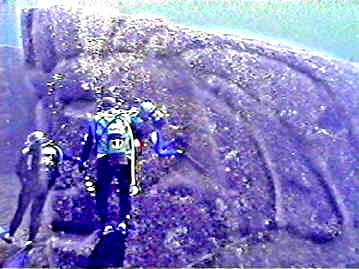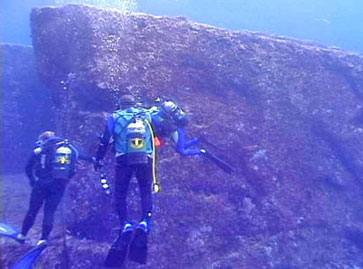|


by
Frank Joseph
(A.R.E. Press, November 2001)
from
HuttonCommentaries Website
Preliminary Remarks
Some A.R.E. members will like this book because of the author’s
fluid writing style. And except for the fact that there are a number
of references to an author named “Cerve,” whose book is not listed
in the bibliography, the text is well edited. There is an annoying
lack of maps, however. Maps are needed because the geographically
wide-ranging text often carries the reader into unfamiliar places.
In spite of the authors engaging exposition, there is much that
readers familiar with the Cayce readings will find contentious,
confusing, or just plain wrong. To begin with, Frank Joseph’s
writing sometimes exhibits what can best be described in present-day
parlance as “having an attitude.” We first noticed this
characteristic in his review of a meeting of archaeologists in July
2001. Mr. Joseph writes of the academics present in this vein:
“The presenters were all
hard-core members of the Scientific
Establishment, something of a club one joins upon university
graduation. You are expected to support your colleagues’ research,
and they yours. If you don’t, you’ll be tossed out, and your tenure
snatched away (see Ancient American, v. 3, issue 19/20, p.
72).”1
Now I’m not an archaeologist, but I associated with several of them
in graduate school. I think they would find it contentious to learn
about the above-described mutual-protection society operating in
their profession. Also, just how do archaeologists make any progress
if they go around protecting each other all the time?
As for geologists, when
Joseph finds that they do not agree with him
on a position he favors, he ridicules them as “university-trained
debunkers” (p. 20). But when he needs geologists to help make his
case he refers to “what modern geologists tell us” (p. 93). But the
best example of Joseph’s support-seeking from geologists is to me, a
geologist, exemplified when he writes (p. 25):
“Cayce’s account of major geologic upheavals in ancient times was
verified by a 1958 Ph.D. dissertation entitled “Earth Changes.”
After comparing fifty representative examples of Cayce’s life
readings dealing with planetary upheavals to modern knowledge of the
earth sciences, the report concluded, ‘Most of the readings on
pre-historical subjects were given in the 1920s and 1930s, and were
all on file before 1945. It is thus clear that the majority of the
psychic statements antedate nearly all of the striking discoveries
recently made by such youthful fields of scientific endeavor as
deep-sea research, paleomagnetic research, and research on the
absolute age of geologic materials. Whereas the results of recent
research sometimes modify or even overthrow important concepts of
geology, they often have the opposite effect in relation to the
psychic readings, in that they tend to render them the more
probable.’”
I recognize this quotation by Joseph because the words are the same
as those that I wrote 43 years ago in my booklet, “Earth Changes:
Past - Present - Future.”
2 Incidentally, my Ph.D. was granted in
1956, not 1958, and my Ph. D. dissertation was not entitled “Earth
Changes.” Indeed, I had not written a page on the subject until
1958. Here, Joseph seems guilty of both sloppy research and an
excess of creative imagination. Also, to say that I verified 50
accounts in Cayce’s readings of major upheavals in ancient times
significantly misrepresents the substance of my booklet.
Now that we have established
Mr. Joseph’s credentials as a
no-nonsense basher of credentialed geologists and archaeologists,
and as one who casually misrepresents the works of others, let’s see
what capabilities he brings to interpreting the Cayce readings on
Atlantis and Lemuria.
The Cayce Readings vs. Joseph’s Thesis of Ancient History
First and foremost,
Mr. Joseph’s ability fairly to interpret Cayce’s
readings is seriously compromised by the view of ancient history
that he brings to the task. In his Introduction (page xiii) we learn
that Joseph believes that the end of Atlantis occurred “at the end
of the Late Bronze Age, around 1200 B.C.” He has believed this for
over a decade,3 and this is his agenda.4 Trouble is, this date is
8,700 years out of step with Cayce’s approximate date of 9,900 years
B.C. for the final destruction of Atlantis! (Refer to readings 364-4
and 288-1).
Wouldn’t you think it incumbent on Joseph to spend the remainder of
his book elucidating this monstrously important discrepancy? After
all, the cultural and geophysical events surrounding the 1,200 B.C.
date become the prism through which he analyzes all of Cayce’s
Atlantis and Lemurian readings. Should Joseph not make extensive and
careful comparisons between Atlantean pre-historical events based on
Cayce’s readings and those cultural and geological events that form
the foundation of his Late-Bronze-Age historical agenda? But no. He
simply passes over the 8,700-year age discrepancy by simply
asserting that the Egyptian high priest who narrated the story of
Atlantis to Solon,
“spoke in terms of lunar years while the Greeks [Solon, and later
Plato] knew only solar years. The discrepancy perpetuated itself
whenever numerical values were mentioned. Given the common error in
translation, the hitherto unmanageable date [of Cayce’s’] comes into
clearer focus…”
Although Joseph amplifies a bit on this thesis (pp. 93,94) in his
chapter entitled “Cayce’s Dream of Lemuria,” he does not make
anything like a comprehensively convincing case that the final
destruction of the Atlantis of Cayce’s readings is equivalent to the
demise of a Late Bronze Age citadel. Joseph’s inadequately supported
position for a the final destruction of Atlantis around 1,200 B.C.
leaves the reader in a limbo of intense confusion, unable fully to
comprehend either side of the contention that the author posits at
the outset of his book.
Ancient Posiedia Was NOT Located In The Bahamas
Chapter 3 of Joseph’s book is entitled, “Did Cayce Predict The
Discovery of Atlantis?” To answer this question he looks first to
evidence for Atlantis at Bimini, two small islands in the
northwestern Bahamas about 55 miles east of Miami. A central point
of Joseph’s examination is based upon a presumption that
Bimini,
“anciently belonged to the western portion of the Atlantean Empire
known as Poseidia… In 1933, Cayce described it as ‘the
sunken portion
of Atlantis, or Poseidia, where a portion of the temples may yet be
discovered, under the slime of ages of sea water - near what is
known as Bimini, off the coast of Florida’ (440-5).”
We disagree with this interpretation of reading 440-5, as discussed
below. There was no ancient “Atlantean Empire known as Poseidia,”
according to a strict interpretation of the readings. After the
original continent of Atlantis split into five islands around 17,400
B.C., when much of Atlantis near the Sargasso Sea “went into the
depths,” the largest and most important of the remaining islands was
Poseidia. As to the location of Poseidia, we said in our review of
Issue 1 of A.R.E.’s Ancient Mysteries newsletter:
“Here is the reading for the gentleman who in a former incarnation
on Atlantis had been involved with the use of the firestone, or
great crystal. This energy-concentration and energy-transmission
device was also known in those times when it was employed for
destructive purposes as ‘the terrible crystal.’ Note: I have added
numbers in brackets to help readers separate the phrases that
describe the three different prime locations of the
crystal-construction information. This reading has to be “parsed”
because the original punctuation can easily be misinterpreted to
make no sense relative to reading 2012-1. Reading 2012-1states
unequivocally that the records of Atlantis are in three places,
the Atlantean land that sank and which is rising again, the
Egyptian
land, and in Yucatan. Furthermore, the Bimini area is not of “the
sunken portions of Atlantis, or Poseidia” (see point 1 just below),
but the Azores area may have been. Also, the Azores may be rising
again (2012-1), which the Bimini area most emphatically is not).
“About the firestone that was in the experience did the activities
of the entity then make those applications that dealt with both the
constructive and destructive forces in the period….
“As indicated, the records of the manners of construction of same
[the great and terrible crystal, or Tuaoi Stone, or
firestone] are
in three places in the earth, as it stands today:
[1] in the sunken
portions of Atlantis, or Poseidia, where a portion of the temples
may yet be discovered, under the slime of ages of sea water
[2]
near what is known as Bimini, off the coast of Florida
[3] in
the temple records that were in Egypt, where the entity later acted
in cooperation with others in preserving the records that came from
the land where these had been kept
Also the records that were
carried to what is now Yucatan in America, where these stones (that
they know so little about) are now - during the last few months -
BEING uncovered.
440-5; December 19, 1933
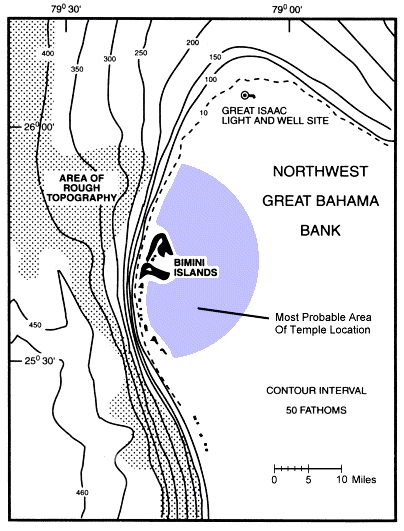
Figure 1 - The Bimini Islands on the Northwestern Bahama Bank,
and
Probable Location of the Remains of a Temple Built By the Poseidians.
Reading 440-5 is the only one that indicates that any kind of
records are stored in the temple near Bimini, or in any other
supposed Atlantean structures in the Bimini
area.5 And these records
are specific to the methods of construction of the great crystal, or
firestone. We don’t know just where this temple is located, but the
shading on Figure 1 above, is a best-guess as to the probably area in which
it might be found.
We show rather convincingly, we believe, that
location 1 in the
quote from 440-5 is the present Azores area, if indeed Cayce’s
readings and Prof. Zhirov’s treatise6 have any validity at all. We
thus reject Joseph’s unsupported assertion that ancient Poseidia is
the same as the Bahamas area. It’s easy to understand, however, how
Joseph made his interpretation because the reading is difficult to
understand unless it is interpreted in relation to other relevant
readings. Also, the author may have been confused by reading 996-12,
which says:
(Q) Is this [the Bimini area] the continent known as
Alta or Poseidia?
(A) A temple of
the Poseidians was in a portion of this land.
Now just as, say, the Mormons have their headquarters in
Salt Lake
City, they also have a temple in Hawaii. Could not something similar
have been the case for a Poseidian temple in the Bahamas, far to the
west of the island of Poseidia in the area of the Azores? (The
Mormon and the Poseidian temples would each be roughly 3,000 miles
away from their corresponding “home bases”).
In spite of the complete lack of readings’ evidence that
Bimini was
Poseidia, Joseph continues with his unfounded assertion throughout
the text. In his chapter on “The Great Lesson of Atlantis,” he makes
the following statement (p. 187):
“He [Cayce] identified the
Bahamian island of Bimini with ancient
Poseidia, where, in fact, the underwater Road” was found just when
he said it would be. The credibility of this feature has been
substantially enhanced by supplementary discoveries of colossal
square columns found at the same depth along the Moselle Shoals,
about three miles northeast of Bimini; an upright stone pillar at
the southwestern end of the island; sunken structures resembling
hexagons and the letter “e”; side-scan sonar images of apparent
staircases with rectangular foundations under water; and white sand
effigy mounds in the configuration of a 500-foot-long shark, a cat,
and other, less identifiable figures at East Bimini.”
To these assertions, composed at the least of unverified speculation
and at the most of outright fabrication, we respond as follows:
-
There is NO reading that specifically identifies
Bimini with
Poseidia.
-
There is NO reading that predicts that an underwater road is to be
found near Bimini, let alone in a specific year.
-
The fact that the "colossal square columns" are really just
non-rectilinear granite chunks that are intermixed with, and
partially on top of, modern, steel ship and engine parts makes the
Moselle Shoal "discovery" almost certainly modern. It seems to have
nothing whatsoever to do with Atlantean remains.
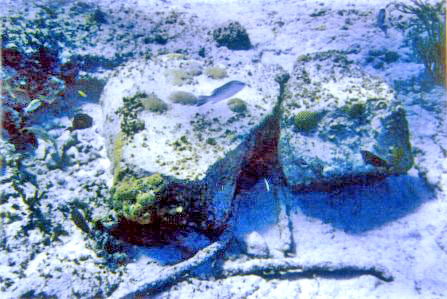
-
The "upright stone pillar at the southwestern end of the island" is
probably little more that a 4-to-6-ft-tall sponge that appeared as a
“pillar” on a side-scan-sonar record that resulted from navigating
the sonar tow-fish in such close proximity to the target that it
made it seem disproportionately large. The “pillar’ has never been
independently verified by visual means, but divers attempting to do
so did discover the sponge in the immediate vicinity.
-
While the "sunken structures resembling hexagons and the letter “e”
show no hard evidence for being other than patterns of seagrass
against a white, sandy bottom, attempted verification by
investigators of the side-scan-sonar images, supposedly depicting
"staircases with rectangular foundations under water", found only
shallow ledges and pockets on the sea floor.
-
Any proof that the "white sand effigy mounds in the configuration of
a 500-foot-long shark, a cat, and other, less identifiable figures
at East Bimini" are man-made features is yet to come. (If one sees
clouds in the sky that resemble various animals or objects does that
mean the resemblance is other than coincidental?)
What about the Cayce reading that says: “Poseidia will be among the
first portions of Atlantis to rise again. Expect it in ’68 and ’69;
not so far away”? (958-3) Joseph thinks that the reading fragment
indicates a Bahamian location for Poseidia. This surmise of his is
critical to several aspects of his central thesis. We will now show
that his is likely not a valid interpretation. Consider first the
following reading. It was given on June 28, 1940, for a 31-year-old
divorced woman who had been told that she was currently undergoing
difficult times.
For, the entity is one of those from the Atlantean activities; and
thus, in a manner, will be one that will either advance through the
hardships and disappointments which have arisen, and may arise, or
that will allow such to become the stumbling stones for the bringing
of disturbances to make the entity dissatisfied; and thus losing the
opportunities that are given each soul.
The relevant part of the reading goes:
Not that these will always be material conditions, for they - too -
will pass.
In that experience the entity was among the children of the
Law of
One who accepted and forsook much of those activities because of its
close associations and companionships with one of the sons of Belial
[those who had no moral code].
This brought consternation to the entity, and also those influences
the application or use of which brought destruction to the land. And
Poseidia will be among the first portions of
Atlantis to rise again.
Expect it in sixty-eight and sixty-nine (’68 and ’69); not so far
away!
We interpret this reading to mean that the entity was living in
Poseidia (now in the area of the Azores) during the time of its
final destruction. If so, did anything at all happen in the Azores
during 1968 and 1969 that might be related to the beginning of a
gradual (1602-3) rising of Poseidia? Only a major earthquake in the
heart of presumed (and now submerged) Poseidia. (See Fig. 2 below).
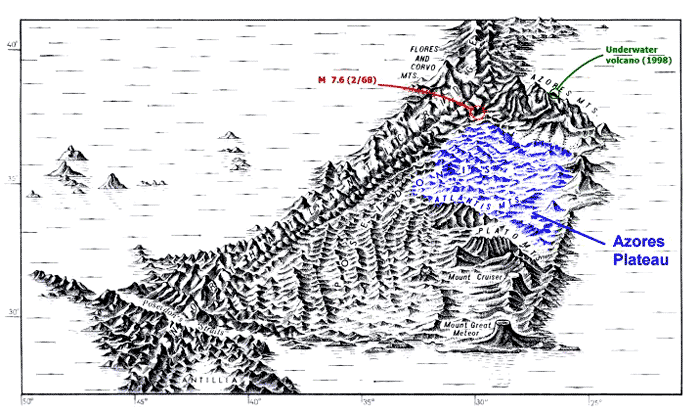
Fig. 2. Physiographic Reconstruction of Poseidia (called here
Poseidonis), after Zhirov, p. 362.
Note the Location of the Major
(M7.6) Earthquake of 1968.
Recall too this reading fragment, "And Poseidia will be among the first portions of Atlantis to rise again.
Expect it [to begin clearly to rise?] in sixty-eight and
sixty-nine…." (958-3)
Has any oceanographic institution made two or more adequately
time-spaced bathymetric surveys of any part of the ocean-floor area
of Figure 2 above, that might corroborate, or refute, whether or not the
sea bottom has risen there within the last 40 years or so? We doubt
it. And so, this prediction of Cayce reading 958-3 remains untested.
In any event, we maintain,
1) that Cayce reading 958-3 which
predicted the “rising of Poseidia” did NOT mean that the Bimini area
was to begin to rise in 1968 and 1969, and
2) that since nothing
rose from the sea in the Bimini area during that time it is
pointless for people to waste time and effort investigating either
natural or man-made superficial features of the Bimini offshore areas.
The places to search will be,
..that along the north and eastern shores of the north and northern
portion of the south island” [for they are predicted to reveal]
“many various minerals, and various other conditions that will be
remunerative when the projects are undertaken; and well that the
ones that do such labors - as the dredging as necessary ..be
followed close in their operations, for these will uncover many
various conditions…
(996-12; March 2, 1927)
A modest proposal do such dredging is given on page 187 of
Hutton’s book.7
The Bimini Road
In his opening description of the so-called
Bimini Road, Joseph
refers to its “huge” square-cut blocks. The blocks, known to
geologists as beachrock, however, are generally at most no more than
about 10 by 10 ft wide and 2 to 3 ft thick. It seems a stretch to
call such stones “huge.” Big maybe, but not huge. Furthermore, they
are pillow-shaped in cross section, their originally right-angled
corners having been trimmed back, chiefly by boring mollusks and sea
urchins. All of the blocks are of coarse-grained limestone lying on
a stratum of denser limestone of finer grain.”
8 And there is no
evidence that the road has a man-made identity, as claimed by
Joseph. Such an assertion has been denied by virtually all
geologists who have studied the submerged formation. Joseph,
however, launches into a series of undocumented and un-referenced
assertions to the effect that “skeptics” [who are they?] “chose to
ignore anything [of what nature?] which postdated their
pronouncements” that the structure is a work of nature, not man.
Joseph talks about adjacent stones in the road containing different
geological components, but gives no information about where samples
were taken, who made analyses, or what exactly was found relative to
these “geological components.” He pointedly ignores the work done in
1979 and 1980 on two areas of the beachrock formation by Marshall McKusick and Eugene Shinn,9 an anthropologist and a geologist,
respectively. These scientists took 17 oriented cores of the
limestone boulders and examined them with X-radiographs. The cores
from both areas showed “slope and uniform particle size, bedding
planes, and constant dip direction from one block to the next. If
the stones had been quarried and re-laid there is no reason to
suppose bedding planes would carry stratigraphically from block to
block. The sedimentary laminations clearly show that these were not
randomly laid stones but a natural, relatively undisturbed
formation.”
Using C-14 dates from eight samples, and in consideration of the
worldwide rise of sea-level in the Holocene, the scientists
determined that, “The rate of submergence [of the formation], over
[a period of time] 2,200 to 3,500 [radiocarbon] years [ago] would
account for 5.58 to 7.22 feet of the 15 feet of submergence.” Thus
Joseph’s “Road” is a quite youthful example of a submerged beachrock
formation, and it has nothing to do with the Atlantis of
Cayce’s
readings. The scientists also note that, “the road’s hairpin curve
is not continuous and parallels the existing headland on shore.”
This shoots down another of Joseph’s ridiculous claims, one in which
he implies that because the beachrock formation is not parallel to
the present shoreline [and if it is not a road after all] it is
somehow a man-made quay or harbor wall. Thus, thanks to McKusick and
Shinn’s observations, the often mentioned “mysterious J curve” in
the formation is natural as well.
Joseph claims that divers found granite in the vicinity of the Road.
We presume that he is unaware that the Corps of Engineers in Miami
once paid a contractor for a load of shipwreck granite to be
transported from the “Road” area to a jetty under construction in
south Florida. This section of the book reminds us of after-dinner
story telling at best.
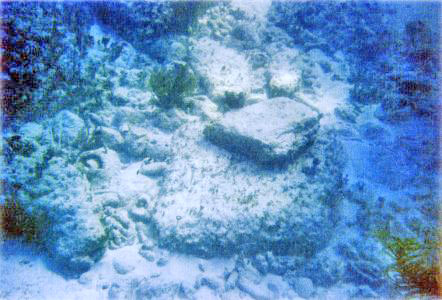
Joseph says that “sometimes the blocks are placed one atop another.”
Well, Harrison and his associates never saw such in their 1969
surveys, but they did pick up a broken piece of one of the blocks
and set it on top of its parent block. Is that what Joseph’s
un-named “investigators” saw? Later, he says, “Beach rock comprises
a single layer, compared to the three and four layers of stone in
the Road... [and]... “the Road’s blocks are several feet thick.”
[Please show photos or other evidence, because there are NO places
that we know of in this formation where there are “three and four
layers of stone”!] Then waxing archaeological he says, without
providing any evidence, “The Road also contains several angular
‘keystones’ with notches to fit into tenons, a prehistoric building
style encountered among the Andean walls of Cuzco,
Sacsahuaman, or
Machu Picchu” (p. 21). This leads him to a line of “similarity
speculations” that move quickly to Roman ruins in Morocco and to
Inca stonework in the Andes. Joseph even provides a photo of the
pre-Inca fortress of Sacshuaman in Peru, which he says “displays
stonework reminiscent of the Bimini Road.” The photo he provides
shows truly huge boulders that appear to be about five ft high,
composing a wall five courses high. The 25-ft-high wall is NOT
reminiscent of the so-called Bimini road, except perhaps in the mind
of a person who thinks differently than a university-trained,
“debunker” geologist like your intrepid reviewer.
Our last comment about the
Bimini Road relates to Joseph’s statement
that
“The Lucayans also knew
Bimini as ‘the Place of the Wreath (or
Crown),’ which may refer to the Road’s originally circular
configuration.”
Good heavens! Is Joseph saying that a relatively
short, straight stretch of submerged and decaying beach rock was
once part of a circular road? Mercy, mercy!
Joseph’s Crystal Skull is not Cayce’s
’Terrible’ Crystal
Roughly seventeen percent of Joseph’s book is devoted to the great
and terrible crystal of Atlantis and to the famous
crystal skull
found in 1926 by the daughter of F.A. Mitchell-Hedges while he was
involved in excavating Mayan Lubuaantum in Central America. One
wonders why so much space was taken up. This finally becomes clear
at the end of the three chapters that are devoted to crystal
considerations. First, Joseph deduces from the works of others that
the quartz crystal skull is that of the Maya’s Ixchel, wife of the
man who built Yucatan’s magnificent Chichen Itza. As the author
says, “Regarded as the founders of Mesoamerician civilization, the
couple arrived at Yucatan after a great natural disaster far out at
sea.” Then, in a leap of unbounded speculative energy, Joseph avers
that,
“With Ixchel, the Atlantean aspects of the
Crystal Skull are
apparent. Even her sky serpent conforms to leading theories
concerning the demise of Atlantis, which describe the catastrophe as
the result of earth’s close brush with a comet. Its meteoric
material bombarded the surface of our planet, triggering geologic
consequences for the ultimate destruction of Plato’s island….[and]
..Certainly, no other known object more resembles that
civilization’s Tuaoi stone, the “mighty, the terrible crystal’
described by Edgar Cayce as the chief instrument of the Atlantean
catastrophe.”
Once again, a reader familiar with the readings’ story of
Atlantis
is forced by Mr. Joseph to try to fit his understanding of Cayce’s
demise of the continent into a wholly new framework advocated by the
author. For Joseph is talking about the end of Atlantis as being in
1,200 B.C., not 9,900 B.C. To Joseph, the demise of Atlantis is that
of a Late Bronze Age citadel, and the end comes by “meteoric
bombardment,” not by the wasting away of the land and subsequent
sinking beneath the sea. Joseph is not talking about Cayce’s
readings (364-4, 288-1) that speak of a 12,700 to 9,900 B.C. period
of “...WASTING away in the mountains, then into the valleys, then
into the sea itself, and the fast disintegration of the lands,” and
then the sinking of the last island of Poseidia below the waves.
There is a picture of the crystal skull in Joseph’s book. The
caption reads, “Is this ‘the terrible, mighty crystal’ of
Atlantis
described by Edgar Cayce?” Our answer, “No, it is not!” Variations
of the design and uses of the great crystal are well discussed in
the readings and there is no need to pretend that the readings’
crystal is anything at all like a quartz-crystal skull.
The key reading that discusses the
great Atlantean crystal, and
which mentions the variations in its nature and use over time, is
2072-10. This reading, and the findings of Dr. John Sutton, now
retired from NASA, show that the Atlantean crystal of the Cayce
readings and the Mitchell-Hedges’ artifact have nothing whatsoever
in common. The reading begins:
Q. Going back to the Atlantean incarnation -- what was the
Tuaoi
[pronounced "too-oye"] stone? Of what shape or form was it?
A. It was in the form of a six-sided figure, in which the light
appeared as the means of communication between infinity and the
finite; or the means whereby there were the communications with
those forces from the outside. Later this came to mean that from
which the energies radiated, as of the center from which there were
radial activities guiding the various forms of transition or travel
through those periods of activity of the Atlanteans.
It was set as a crystal, though in quite a different form from that
used there. Do not confuse these two, then, for there were many
generations of difference. It was in those periods when there was
the directing of aeroplanes, or means of travel; though these in
that time would travel in the air, or on the water, or under the
water, just the same. Yet the force from which these were directed
was in this central power station, or Tuaoi stone; which was as the
beam upon which it acted.
In the beginning it was the source from which there was the
spiritual and mental contact.... First it was the means and source or
manner by which the powers that be made the centralization for
making known to the children of men, and children of God, the
directing forces or powers. Man eventually turned this into that
channel for destructive forces -- and it is growing towards this in
the present.
The A.R.E. Journal for January 1974, carried an article entitled
"The Tuaoi Stone, An Enigma," by Dr. John Sutton, a
NASA employee.
After an exhaustive study of all of the readings on the Tuaoi Stone,
Sutton drew the following picture of this power source. (Note
especially point 3).
The "stone":
(1)
became hot when used
(2) it was large
(3) it
received its energy from the Sun and from elements that are and are
not found in the Earth’s atmosphere
(4) it consisted of prisms or a
"glass"
(5) it employed induction method
(6) it employed a kind
of wave energy other than electromagnetic
(7) the energy could be
emitted in a beam to which water and other matter is transparent;
(8) the beam was invisible
(9) the beam transmitted enough power
for the needs of a city
(10) it could be used to retard the aging
process
(11) it consisted of two separate pieces -- a cylinder and
a capstone
(12) the energy produced was concentrated between the
two pieces
(13) representations of it will be found in Yucatan
(14) the crystal was cylindrical, six-sided, or was of hexagonal
cross-section
(15) light waves were used for communications with
extraterrestrial intelligence
(16) misuse, accidental or
otherwise, of the Stone caused [two] geological upheavals
Hyping the Yonaguni Colossus?
Finally, speaking of pictures, there is another in
Joseph’s book
that is worth mentioning. Our Figure 3 below, is a duplicate of the figure
in Joseph’s book. The rock face is, supposedly, possible evidence
for lost Lemuria. It is located underwater near the Japanese
island
of Yonaguni, about 80 miles east of Taiwan. Joseph describes it as,
“A colossus under some twenty feet of Pacific Ocean near
Yonaguni.
Although the authenticity of this photograph is unconfirmed, it may
represent the most dramatic visual evidence for the sunken site’s
man-made identity. The stone head appears about thirty feet tall,
but its style and headdress resemble no known provenance.”
Figure 3 -
(Left) Heavily retouched photo used in Frank Joseph’s
book representing
"the most dramatic visual evidence for the sunken
site’s man-made identity".
(Right) Unretouched photo of exactly the
same scene but showing none of the artistically created features.
Rhetorical Questions and a Recommendation
The foregoing review, while not comprehensive, shows that there is
enough material in the book that is contentious, confusing, or
downright erroneous that almost anyone familiar with the relevant
Cayce readings is prompted to ask, “How did this book come to be
printed under the A.R.E.’s imprimatur?” Why wasn’t the manuscript
sent out to one or more competent reviewers for critical evaluation,
prior to being edited?
What does it say to new members, to say nothing of those members
that have been with the organization for some time, to receive a
book of such poor quality as an A.R.E. Sponsoring Member "benefit"?
One might reasonably conclude that the organization’s management has
no interest in cultivating a membership that can think critically or
that can appreciate the results of carefully researched work. This
perception can be mitigated by the emplacement of adequate review
procedures for all manuscripts submitted to A.R.E. for publication.
-
Mr. Joseph
is editor of the Ancient American magazine. This
quote is from Atlantis Rising, 2001, no. 30, p. 24.
-
The quote is from the abstract (p. 2) of Anonymous, 1959, A.R.E.
Press, Virginia Beach, 23451, 80 pp.
-
Frank Joseph (FJ) was interviewed by
Linda Moulton Howe (LMH) on
11/19/01, as reported in her Update On Underwater Megalithic
Structures Near Western Cuba
-
LMH: HOW FAR BACK WOULD YOU PUT THIS [Atlantis] SINCE PLATO SAYS,
GOING THROUGH SOLON AND IN THE CRITEAS, ’9000 YEARS,’ AND THAT WOULD
PLACE IT AT ABOUT 11,500 YEARS AGO?
-
FJ: No, that’s another story altogether. My colleagues and I have
worked very hard since the 1980s on these dates. And those dates are
a mistake, that was a mistake in translation. The Greeks used a
calendar that was very similar to ours. They used a solar calendar
of about 365 days. A standard solar calendar. The Egyptians used a
minimum of five different calendars, including a solar calendar.
Their priests and holy places where they had the story of Atlantis
which was at the holy place called the Temple of Knife in
Egypt.
They used a lunar calendar.
We concluded that the Egyptian priest, when he said 9,000 years, is
talking about lunar years and not solar years. There is abundant
evidence to show that is exactly what he was saying. And the Greeks,
when they heard this, they thought solar years. So when Plato - all
of the numerical values in the Criteas and the Timaeus are totally
inflated beyond reality. They do not work with the description that
Plato gives. Plato describes a late bronze age citadel or city.
There was a huge gap in knowledge between Plato’s and
Solon’s time
and what happened in Atlantis. Because we now know that when the
Bronze Age stopped suddenly around 1200 B. C., that for the next 400
years at least there was a period of profound Dark Age...
There was a symposium of archaeo-astronomers back in 1997, not
New
Age people at all, in England, in which they found that probably the
greatest natural catastrophe human beings ever witnessed was around
1200 B. C. And that was when two or more comets, including Haley’s
Comet, converged in the skies over earth and showered the world with
a barrage of asteroids and meteors that pushed human beings to the
brink of extinction.
And Atlantis was especially hard hit because there are two Swedish
physicists, Thomas Larsson and Lars Franzen, who
established in 1997 that several asteroids - I’m not
talking about meteorites - several asteroids!
collided in the eastern Atlantic precisely in
the location of Atlantis and that is
why we can explain why an island the size of
Atlantis which was 6,000 square miles - it was not a
continent, it was a big island. And it was
destroyed. If you have an island out in the middle
of the water and it’s hit by several nuclear blasts
at once, the chances of that thing being around are
slim.” {Fair Use rules apply to these quotations,
for review purposes}
-
Interestingly,
R. Malaise, in a monograph entitled Atlantis as a
Geological Probability (1951, Stockholm), as cited in N. Zhirov’s,
Atlantis (1970, Moscow, Progress Publishers) wrote in a similar way
some 50 years ago. Zhirov writes, “Malaise dates the final
subsidence of Poseidonis [Poseidia] as 1200
B.C., linking this date up with the invasion by the ‘peoples
of the sea’ in the region of the Mediterranean.”
-
Ancient Mysteries asserts, “Much exploration has been done in the
area of the Bimini Islands since discovery of the so-called
Bimini
Road in 1968. The Cayce readings had predicted the discovery of
ruins in that area during that year.” But there are NO Cayce
readings that predicted the discovery of ruins in the Bimini area in
1968. NONE.
-
Zhirov, N.,
1970, Atlantis, Progress Publishers, 438 pp.
-
Hutton, W., 1996, Coming Earth Changes, A.R.E.
Press, Virginia Beach, VA, 23451, 346 pages.
-
Harrison, W., 1971, Atlantis Undiscovered - Bimini, Bahamas, Nature,
v. 230, no. 5292, p. 287-289.
-
McKusick, M. and E. Shinn, 1980, Bahamian Atlantis Reconsidered,
Nature, v. 287, no. 5777, p. 11.
|





